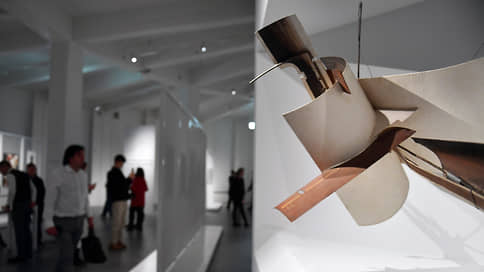Simple as bread – Newspaper Kommersant No. 220 (7421) dated 11/28/2022
[ad_1]

Exhibition “1922. Constructivism. Nachalo” opened the cultural and educational center “Zotov”: more than 300 exhibits – from avant-garde paintings to models of unbuilt buildings – tell about the most important direction of Soviet art. But the main exhibit of the exhibition is the building itself, which houses the center – the former bakery No. 5, a recently restored monument of constructivism. Tells Igor Grebelnikov.
At the former bakery, the most ordinary traces of the Soviet past have been preserved with amazing reverence – featureless Soviet tiles on the walls or patched and patched brickwork – even though they do not date back to the time the building was built (1931), but appeared during endless repairs. Sometimes these are just holes in the place of a fallen off tile, roughly plastered and covered with paint, but they are also cleaned, conserved, as if it were not a painter’s whim, but an old fresco.
In “Zotov” (the name of the People’s Commissar, and then the Minister of the Food Industry Vasily Petrovich Zotov once bore this bakery), you constantly run into evidence of a past life, but they do not interfere with assessing the reconstruction. The building, purchased by VTB Bank, has been reequipped in the most modern way: in addition to exhibitions, it is planned to hold concerts, film screenings, lectures, and classes for children.
The building of bakery No. 5 shared the common fate of constructivist buildings: many of them are in ruins and desolation to this day. More fortunate are the monuments of federal significance, designed by famous architects and having a special conservation status. The building in the form of a cylinder, surrounded by rows of windows, became an object of cultural heritage of regional importance only in 2004, shortly before the territory was bought for development. In 2018, skyscrapers were erected here according to the project of the architectural bureau SPIC (Sergei Tchoban and Igor Chlenov). Three 44-story towers in the form of elegant plates, coupled with a cylinder building, look like a Suprematist composition, especially in one of Tchoban’s sketches. But in reality, it turned out to be a rather unusual residential complex with an ambitious cultural center: in this way, love for the architectural avant-garde has not yet been instilled in Moscow.
In architectural terms, this cylinder does not give the impression of something revolutionary: the novelty of the automatic bakery, designed by Georgy Marsakov (1886–1963), was in the principle of its operation. The production was a continuous conveyor: on the upper, fourth tier, the flour was sifted, then the ingredients were loaded into dough mixers, the bread baking process went down gradually, and on the first floor the loaves were loaded into trucks for delivery to stores. The technology allowed to produce up to 200 tons of bread per day. In total, seven such cylindrical bakeries were built, but only this one survived.
Now these walls are being filled with new content: the Zotov Center calls itself “the first institution in Russia entirely dedicated to the legacy of constructivism.” The exhibition “1922. Constructivism. The Beginning” outlines both the scope and the limit of these ambitions. Exhibits for it were provided by 17 museums and 5 private collections. Here and textbook things, and rarities, rarely getting out of the storerooms. The curators proceed from the fact that the year 1922, indicated in the title of the exhibition, was the year the constructivists entered the field of practical activity – the publication of books, magazines, the design of buildings, the creation of plays and films. In fact, there is no definite date that could mark such a clear transition from theory to practice. Alexander Rodchenko, one of the main heralds of constructivism, and his closest associates in Inkhuk and VKhUTEMAS even earlier declared the painting a bourgeois relic, and chose a new function for themselves – “yesterday the artists – today the designer.”
The cylindrical shape of the building also determined the design of the exhibition: rounded metal lattices, on which the exhibits are placed, diverge in concentric semicircles, resembling ripples on the water. Almost all trends in Russian art of the beginning of the 20th century, which preceded the new artistic task – “production of things” are united on one floor. But still, starting a conversation about this with Goncharova’s primitivism or Kandinsky’s abstractions is too long a way. On the other hand, an approach in which all the significant names and trends in the art of that period are nearby – cubism, futurism, abstruse poetry, suprematism – can turn the viewer’s head so much that they want “practical” clarity as soon as possible. Another floor is dedicated to her, which is divided not so much by paintings as by models, sketches of buildings, models of monuments, stills from films, pages from books, scenery for performances, photographs of dance numbers, sounds of “industrial” music. The exhibits interrupt each other, creating an image of an energetic era, but at the same time not clarifying the essence of the new language of art, which irrevocably changed life. Perhaps the curators should have been even more imbued with the history of these walls with in-line production, which reliably led from flour to bread, from idea to result.
[ad_2]
Source link






